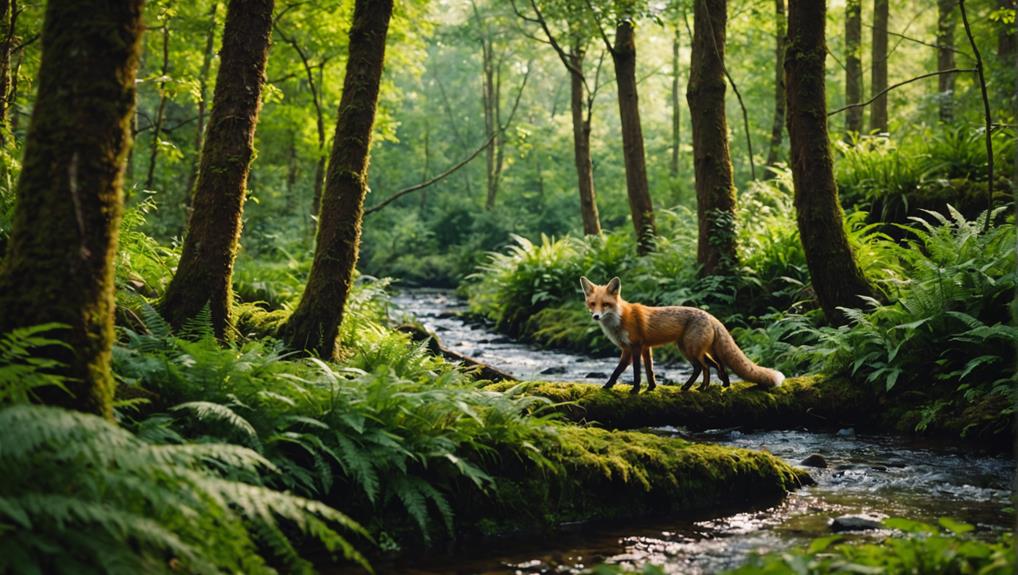Red foxes really know how to make themselves at home! You'll find them thriving in all sorts of habitats, from dense forests and grassy fields to the heart of bustling cities. They're quite adaptable, often benefiting from life in urban areas where they can scavenge and find food more easily than in quieter rural spots. In fact, many urban foxes live in parks or even stadiums, raising their cubs with a cheeky charm. But it's not all fun and games; challenges like habitat loss and competition can threaten their survival. Stick around, and you'll discover more about these clever creatures!
Contents
- 1 Red Foxes: A Global Presence
- 2 Diverse Habitats of the Red Fox
- 3 Adapting Across Continents
- 4 The Red Fox in Urban Environments
- 5 Habitat Suitability and Preferences
- 6 Ecological Interactions and Impact
- 7 Threats to the Red Fox's Habitat
- 8 Conservation Efforts for Red Fox Habitats
- 9 Human Interactions With Red Foxes
- 10 Future of Red Fox Populations
- 11 Final Thoughts
Red Foxes: A Global Presence
Red foxes are remarkable creatures with a wide-ranging presence across the globe. You'll find these clever critters in many places, from the bustling streets of major cities to the quiet corners of rural landscapes.
In fact, red foxes have a knack for adapting to urban areas, where they often thrive and even form denser populations than in the countryside. Can you believe that they're spotted in 56 cities across the UK alone? That's quite the urban adventure!
These agile animals don't just stick to one habitat; they effortlessly move between urban and rural settings, showing off their versatility. They've become part of the urban wildlife scene, darting through parks and backyards while looking for tasty treats. It's like they've mastered the art of city living!
However, their global journey isn't without consequences. In places like Australia, where red foxes were introduced, they've wreaked havoc on native wildlife.
So, while we admire their adaptability, it's also essential to recognize the challenges they bring. Understanding red foxes helps us balance our appreciation for these creatures with the responsibility we've to protect our ecosystems.
Diverse Habitats of the Red Fox
Red foxes are like the ultimate survivors, thriving in all sorts of habitats from lush forests to busy urban streets.
You might spot them in your local park or even your backyard, showing just how adaptable they're to different environments.
It's fascinating to see how these clever creatures balance their lives between the wild and the city, making the most of whatever space they call home!
Habitat Adaptability Factors
Often found in diverse habitats, the red fox showcases remarkable adaptability that allows it to thrive in environments ranging from dense woodlands to bustling urban areas.
You've probably seen them darting through parks or sneaking around gardens, proving they can make themselves at home just about anywhere. Their habitat adaptability is truly impressive!
These clever creatures prefer mixed landscapes with transition zones, which help them hunt effectively.
They're just as comfortable in agricultural fields as they're in city streets, often finding more food in urban areas than in rural settings.
Have you ever noticed how urban fox populations can be denser? It's because they've learned to raise their cubs and forage successfully amidst the hustle and bustle of city life, like in New York or London.
Seasonal changes also play a role in their habitat preferences.
As food availability shifts, red foxes adjust their foraging strategies and can even cache food for leaner times.
Urban Vs. Rural Habitats
The adaptability of red foxes is particularly evident when comparing their urban and rural habitats. In cities, these clever creatures thrive, often forming larger populations than in rural areas. You might spot them in parks, gardens, and other green spaces, where they find tasty meals and cozy spots to raise their young. It's amazing how they can turn a suburban backyard into their playground!
While red foxes love mixed landscapes like woodlands and farmland, they've been increasingly seen in neighborhoods, proving their knack for fitting into our lives. But the seasons can change their game. When winter arrives, they might swap city life for rural environments, all depending on where the food's at.
Now, let's not forget how urban foxes often get creative with their diets. They may rummage through garbage cans, snatching leftovers to supplement their meals of small mammals and birds. It's a bit cheeky, but hey, survival is key!
Adapting Across Continents
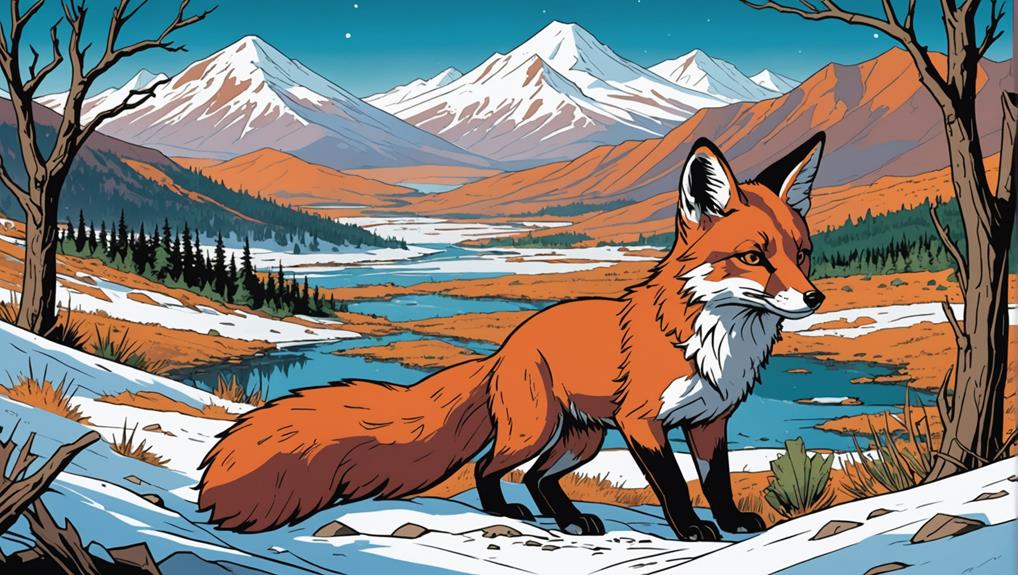
When you think about red foxes, you might picture them roaming through forests or fields, but these clever critters have a knack for adapting to all kinds of places, including bustling cities.
It's fascinating how they thrive in urban settings, often outnumbering their rural cousins, and they don't seem to mind sharing space with humans—just ask the foxes living near Yankee Stadium!
Habitat Preferences and Variability
Red foxes demonstrate incredible adaptability, thriving in a variety of habitats across continents. You might be surprised to learn that these clever creatures can live in forests, grasslands, wetlands, and even urban areas!
Their habitat preferences often lean toward mixed landscapes, like scrub and farmland, where they can easily hunt and find cozy nesting spots.
In urban areas, red foxes have found a unique niche. They often raise their cubs in gardens and parks, taking advantage of the high population densities that cities offer. With fewer disturbances from humans, these sly animals can flourish right in our backyards.
Seasonal changes also play a big role in where foxes decide to hang their tails. As prey availability shifts, they might move to areas rich in small mammals and fruits, always on the hunt for a tasty meal.
Their ability to thrive in human-altered landscapes showcases not just their resilience but also their ecological flexibility.
Urban Versus Rural Adaptation
Many urban foxes have adapted remarkably well to city life, often outnumbering their rural counterparts. You might be surprised to learn that these clever red foxes can thrive in urban areas like parks and gardens, making the most of their surroundings. They're experts at scavenging, finding food in trash cans and gardens, just like their rural relatives do.
What's truly fascinating is how these foxes have found unique spots to raise their cubs, even in places like the grounds of Yankee Stadium! This shows just how adaptable they really are.
And it doesn't stop there—recent studies reveal that urban foxes often travel between city and country, seeking out the best spots for food and mating.
With significant populations in over 114 cities worldwide, including 56 in the UK and 40 in mainland Europe, red foxes demonstrate their remarkable resilience.
They've become a part of our urban landscape, and it's heartwarming to know that they can coexist with us, reminding us that nature can adapt and thrive, even in the busiest places.
The Red Fox in Urban Environments
Thriving in urban landscapes, the red fox has become the most urbanized canid, showcasing remarkable adaptability that allows it to flourish in cities. You might be surprised to learn how these clever creatures make urban areas their home.
- They often raise cubs in surprising spots, like the famous Yankee Stadium!
- Urban foxes enjoy private gardens and parks where they can roam freely and find food.
- They're popping up in cities around the world, proving just how resilient they are!
With higher population densities in cities than in rural areas, red foxes are truly making the most of their surroundings. They cleverly navigate between urban and rural habitats, taking advantage of diverse food sources and even mating opportunities.
Imagine a little fox exploring your neighborhood, sneaking into gardens, and enjoying a snack!
It's essential to appreciate how these red foxes adapt to life in urban areas, reminding us of nature's resilience.
Habitat Suitability and Preferences
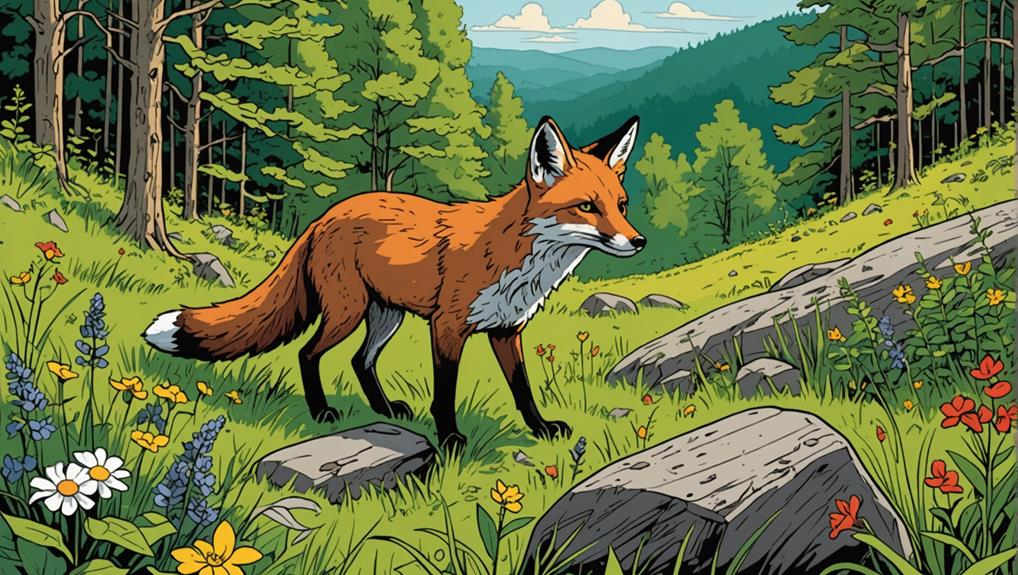
A diverse range of habitats supports the red fox, allowing it to adapt and flourish in various environments. You'll find these clever creatures in mixed landscapes like scrub, woodland, farmland, and even urban areas! Their remarkable adaptability really shines, especially as they make themselves at home in areas altered by humans.
Red foxes have a soft spot for mosaic forests, where young conifer plantations provide plenty of food and cozy shelter. When the seasons change, so do their preferences. They'll seek out different locations based on what's available to eat and their breeding cycles. Research from Tuscany shows they particularly favor scrubwood, meadows, and pine forests.
However, not every habitat is a winner for them. Flat open country, sparse woodlands, and arable fields aren't ideal, limiting how many foxes can thrive there.
Ecological Interactions and Impact
When you think about red foxes, it's easy to see how they fit into the big picture of nature. They help keep the populations of small mammals and birds in check, which is super important for a balanced ecosystem.
However, in some places, like Australia, these clever critters can become a bit of a troublemaker, so understanding their role in prey dynamics and competition is essential for keeping our wildlife thriving.
Prey Dynamics and Competition
Red foxes frequently play a vital role in their ecosystems by regulating populations of small rodents, rabbits, and birds.
These clever creatures adjust their feeding habits based on what's available, ensuring that their environment stays balanced.
Here's why understanding their prey dynamics and competition is so important:
- They help control rodent populations, preventing overpopulation.
- Their flexible feeding habits allow them to thrive in changing environments.
- They face competition from larger carnivores, which can impact their survival.
When food is plentiful, especially with the introduction of game species like rabbits and pheasants, red foxes can flourish.
However, they often find themselves competing with bigger predators like coyotes and wolves.
This competition can change their foraging behavior and influence which prey they hunt.
Invasive Species Concerns
The introduction of red foxes to new environments can lead to significant ecological disruptions, particularly in regions like Australia where they're considered one of the most destructive invasive species. With over 7.2 million feral red foxes roaming around, their impact on native wildlife is nothing short of alarming. They prey on medium-sized mammals, contributing to the decline and extinction of several species.
In Tasmania, the accidental introduction of red foxes has forced local communities to start eradication programs. These efforts aim to protect vulnerable wildlife that's already struggling to survive. It's a tough battle, but it's necessary for the sake of our unique ecosystems.
Here's a quick look at the impact of red foxes:
| Species Affected | Impact | Conservation Efforts |
|---|---|---|
| Potoroidae Family | Decline in numbers | Habitat restoration |
| Native Birds | Increased predation | Breeding programs |
| Small Mammals | Extinction risk | Public awareness campaigns |
| Reptiles | Habitat competition | Monitoring populations |
| Local Ecosystems | Ecological imbalance | Community engagement projects |
You see, every action counts, and preserving our native wildlife is a team effort!
Threats to the Red Fox's Habitat
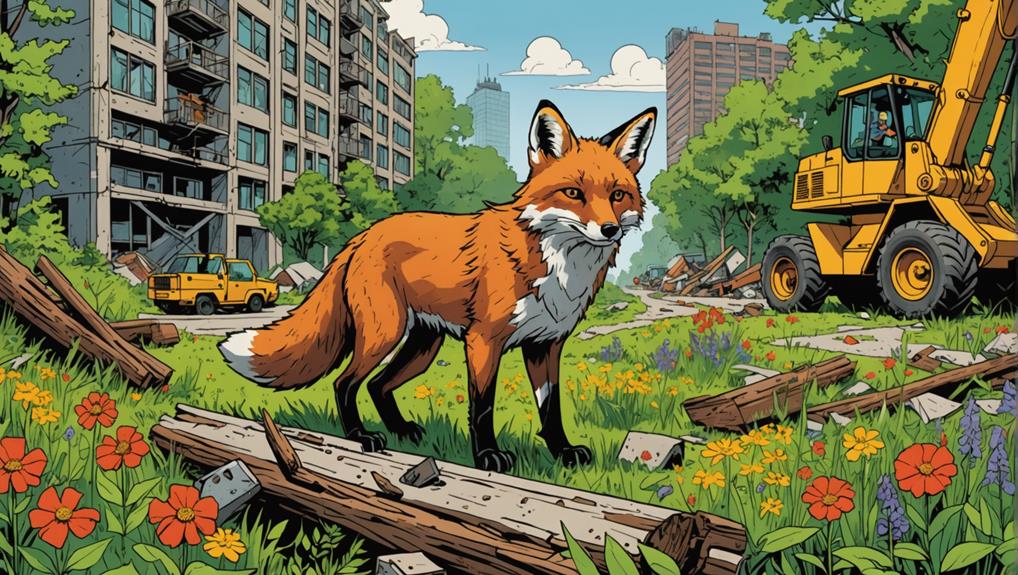
Many factors threaten the red fox's habitat, making their survival increasingly precarious. As you might imagine, these clever little critters face a tough time in today's world. Here are a few key challenges:
- Urbanization: Expanding cities and suburban areas are munching away at their homes.
- Agricultural practices: Fields replacing forests and grasslands limit their food and shelter options.
- Competition: Larger predators like coyotes are moving in, pushing red foxes out of their favorite spots.
You see, habitat fragmentation is a real buzzkill for red foxes. As their living spaces shrink, they struggle to find food and safe places to raise their young.
Urban areas are particularly tough, as traffic and pollution make life even harder for these furry friends.
Plus, climate change is adding to the mix, altering their habitats and prey availability.
Red foxes are adaptable, but they need a hand from all of us. By understanding these threats, we can better protect their homes and ensure they continue to thrive in the wild.
After all, who wouldn't want to see these charming creatures frolicking in their natural surroundings?
Conservation Efforts for Red Fox Habitats
Conservation efforts for red fox habitats play a crucial role in ensuring these resilient animals can thrive in changing environments.
It's heartening to see how communities come together to protect their furry neighbors! By creating and maintaining diverse ecosystems—like mixed forests, grasslands, and even urban parks—we help red foxes adapt and survive.
Public awareness campaigns shed light on how important it's to shield red foxes from urban encroachment and habitat degradation. You can be a part of this movement! Local wildlife organizations partner with communities to set up dedicated wildlife corridors and nesting areas, giving these clever creatures a safe haven.
Ongoing research helps us keep tabs on red fox populations and their habitats, guiding us to tackle challenges like invasive species and habitat competition.
And let's not forget about funding! Programs like the Federal Aid in Wildlife Restoration support these vital conservation initiatives, emphasizing the need for sustainable management practices.
Human Interactions With Red Foxes
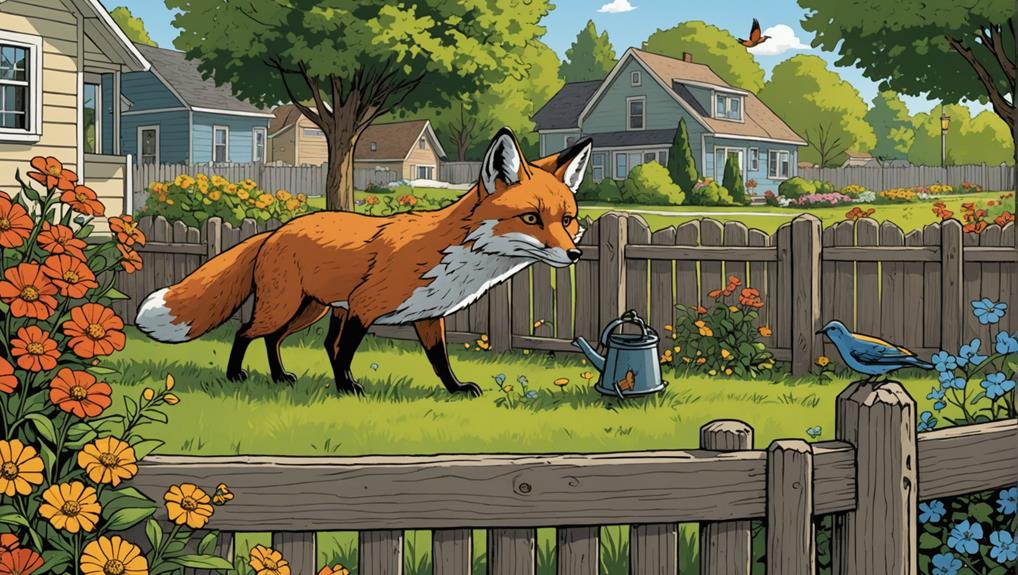
As red foxes adapt to urban and suburban environments, their interactions with humans become more frequent and complex. You might spot these clever creatures rummaging through your garden or even crossing the street on their nightly adventures.
Here are some key points to consider about these fascinating encounters:
- Red foxes are opportunistic eaters, often scavenging from human waste.
- They may occasionally prey on small pets, leading to conflicts with residents.
- Public education on coexistence is crucial for managing these interactions.
In urban and suburban areas, red foxes thrive by taking advantage of their surroundings. Their omnivorous diet helps them find food easily, but this can also lead to misunderstandings with people.
While some residents may see them as adorable visitors, others might view them as pests. Understanding how to coexist peacefully is essential. By learning more about red foxes and promoting awareness, you can help reduce conflicts.
After all, it's not just about protecting pets; it's about appreciating these remarkable animals that share our spaces. So next time you see a red fox, remember: they're just trying to navigate this big human world, just like you!
Future of Red Fox Populations
Looking ahead, the future of red fox populations hinges on their remarkable adaptability and resilience in the face of changing environments. You see, these clever creatures thrive in urban, suburban, and rural areas, showcasing their versatile habitat preferences.
However, as humans encroach on their homes, conservation efforts become crucial. Habitat loss can impact food availability and territorial behaviors, and we need to prioritize these furry friends.
In Australia, red foxes have taken on an invasive role, contributing to the decline of native wildlife. This means we must develop effective management strategies to protect those vulnerable species while ensuring red foxes can still thrive.
Increased public awareness and involvement in wildlife protection initiatives are essential; after all, every little effort counts!
Monitoring genetic diversity within red fox populations helps us understand their adaptability to changing conditions. This knowledge informs conservation efforts, making it even more vital for all of us to join in.
Final Thoughts
So, there you have it! Red foxes are pretty amazing creatures, thriving in all sorts of places, from bustling cities to quiet forests. They've adapted to so many environments, which is impressive! But we can't forget the challenges they face, like habitat loss and human interactions. By understanding their needs and supporting conservation efforts, we can help ensure these clever critters continue to thrive. Let's keep our red fox friends around for generations to come—who wouldn't want to spot one on a stroll?

